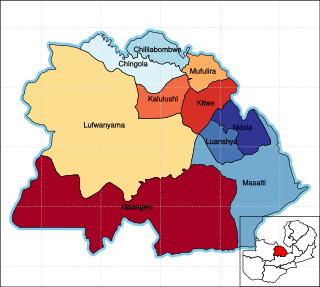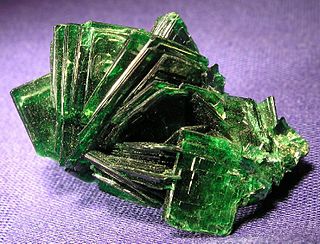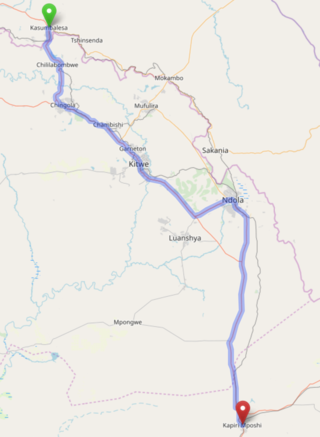
Chingola is a town in Zambia's Copperbelt Province, the country's copper-mining region, with a population of 216,626. It is the home of Nchanga Copper Mine, a deep-shaft high-grade content copper mining operation, which subsequently led to the development of two open pit operations, Chingola Open Pit and then Nchanga Open Pit.

The 1,576 kilometres (979 mi) long Kafue River is the longest river lying wholly within Zambia. Its water is used for irrigation and for generating hydroelectric power. It is the largest tributary of the Zambezi, and of Zambia's principal rivers, it is the most central and the most urban. More than 50% of Zambia's population live in the Kafue River Basin and of these around 65% are urban.

Copperbelt Province is a province in Zambia which covers the mineral-rich Copperbelt, and farming and bush areas to the south. It was the backbone of the Northern Rhodesian economy during British colonial rule and fuelled the hopes of the immediate post-independence period, but its economic importance was severely damaged by a crash in global copper prices in 1973. The province adjoins the Haut-Katanga province of the Democratic Republic of the Congo, which is similarly mineral-rich.

Kitwe is the third largest city in terms of infrastructure development and second largest city in terms of size and population in Zambia. With a population of 517,543 Kitwe is one of the most developed commercial and industrial areas in the nation, alongside Ndola and Lusaka. It has a complex of mines on its north-western and western edges.

Kabwe is the capital of the Zambian Central Province and the Kabwe District, with a population estimated at 202,914 at the 2010 census. Named Broken Hill until 1966, it was founded when lead and zinc deposits were discovered in 1902. Kabwe also has a claim to being the birthplace of Zambian politics as it was an important political centre during the colonial period.

The Copperbelt is a natural region in Central Africa which sits on the border region between northern Zambia and the southern Democratic Republic of Congo. It is known for copper mining.
Chililabombwe is a small town in Copperbelt Province, Zambia. It is located near the Democratic Republic of the Congo border. The name Chililabombwe means 'place of the croaking frog' in the local language of Lamba. The town has a population of 87 000 based on census data from 2010, making it one of the largest towns in the Copperbelt. The town is on the T3 road, 26 km north of the neighbouring town of Chingola, and approximately 10 km south of the large border market of Kasumbalesa. It has also produced national heroes like the late soccer star Eston Mulenga and many others.
Vedanta Resources Limited is a diversified mining company headquartered in London, United Kingdom. It is the largest mining and non-ferrous metals company in India and has mining operations in Australia and Zambia and oil and gas operations in three countries. Its main products are Zinc, Lead, Silver, Oil & Gas, Iron Ore, Steel, Aluminium and Power. It has also developed commercial power stations in India in Odisha and Punjab.

ZCCM Investments Holdings is a successor company to Zambia Consolidated Copper Mines Limited, of Zambia.

Konkola Copper Mines is a copper mining and smelting company in Zambia. It is 80% owned by Vedanta Resources, a mining conglomerate based in Mumbai and London.

Copper is one of the world's most important industrial minerals, and Africa is an important world producer. While output is traditionally dominated by Zambia, South Africa and Katanga Province in the south of the Democratic Republic of the Congo, many African nations contribute to copper production, and many African nations have undeveloped ore resources.

Mining in Zambia produces several minerals and is a critical part of the country's economy. Copper comprises 70% of Zambia's total export earnings, and the country produces about 20% of the world's emeralds. Mineral resources are distributed throughout the country. Zambia produced 763,287 metric tons of copper in 2022.
Copper mining in the Democratic Republic of the Congo mainly takes place in the Copper Belt of the southern Katanga Province of the Democratic Republic of the Congo.

The Musonoi mine is a set of open-cut pits near Kolwezi from which copper and other metals have been extracted since the 1940s. The mining complex is located in the Lualaba Province of the Democratic Republic of the Congo. Kolwezi is about 320 kilometres (200 mi) northwest from Lubumbashi, the provincial capital.
Mopani Copper Mines PLC is a Zambian company that produces and sells copper and cobalt to the international market, being one of the biggest mines and exporters in the world.
Chambishi is a town in Kalulushi District in the Copperbelt Province of Zambia. According to the 2021 Census its population stands at slightly above 11,000. It is located on the T3 road between the cities of Kitwe and Chingola.

Lungowe v. Vedanta Resources plc [2019] UKSC 20 is a UK company law and English tort law case, concerning business liability for human rights violations, environmental damage and the duty of care owed by a parent company.

The T3 is a trunk road in Zambia. The road runs from Kapiri Mposhi via Ndola, Kitwe and Chingola to Kasumbalesa on the border with DR Congo. The entire route is a toll road.
Chilekwa Mumba is a Zambian community organizer and environmental activist. He is known for having organized a successful lawsuit against UK-based mining company Vedanta Resources, owner of the subsidiary Konkola Copper Mines in Zambia's Copperbelt Province, in response to pollution and environmental damage. It was the first time that an English court decided that a British company could be held responsible for environmental harm caused by its subsidiaries operating in another country.














